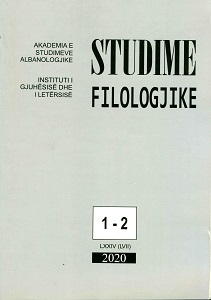Konceptimet e “tjetrit” në poezinë e Naim Frashërit
Conceptions of “the other” in the poetry of Naim Frashëri
Author(s): Abdulla RexhepiSubject(s): Albanian Literature, Theory of Literature, Sociology of Literature
Published by: Qendra e Studimeve Albanologjike
Keywords: "The other"; Naim Frashëri; the Turk; Yazidi; God;
Summary/Abstract: “The other” is a main factor for knowing oneself by the man has long ago begun to take a considerable place in social studies and knowledge. “The other” has been perceived as an object through which an individual knows and understands / perceives himself. In this tradition of thinking “self’ and “the other” stand opposite to each other. The aim of this writing is to identify and analyse conceptions ofNaim Frasheri regarding to “the other”. The presence of “the other” in the literary work of an author results with knowing and identifying “himself’. This presence becomes even denser when the other consciously aims to structure social identities. Therefore, social identities have been constructed in interaction with “the others” and our identity or the identity of the group (“we”) is formed through the process of thinking of ourselves or “us” in relation to “the other”. In the poetry of Naim Frasheri” depending on the literary genre are outlined three main conceptions that mark “the other” of an author. In his poems of national character, “the Turkish / Asian” constitutes “the other” of the Albanian and is the symbol of the evil and regression. While in his religious poetry, Yezid and his family are “the other” of the Bektashian Albanian. As soon as bektashism was politically detached of the Ottoman Sunni Empire, as in the theological field it was detached early ago, for Albanians of this sect is was much easier to think about the establishment of the independent Albanian nation / country and Naim, better than any other Albanian Bektashian articulated his religious / national ideas and conceptions which were in contradiction to the central Ottoman reign. Also, Naim in his mystical creativity has created an “other” at whom he wants to vanish and become “clay and dust”. The mystical hermeneutics doesn’t aim marking, understanding or adoption of “other”\God but instead vanishing on it, loving and sacrificing for him. This way, Para modern epistemologies were structured not on the basis of “the other”, marked by the subject but in relation to “The great Other”, “The God” that is distanced from the earth. This way of perception of “the other” and the understanding of “self’ in relation with him” can imply totally different ontological epistemology. This mystical hermeneutics is somehow different to the philosophical hermeneutics, according to whom, each time we say that we have “understood” something, maybe this way we are adopting something else (or something that belongs to someone else).
Journal: Studime Filologjike
- Issue Year: 2020
- Issue No: 01-02
- Page Range: 123-134
- Page Count: 12
- Language: Albanian

